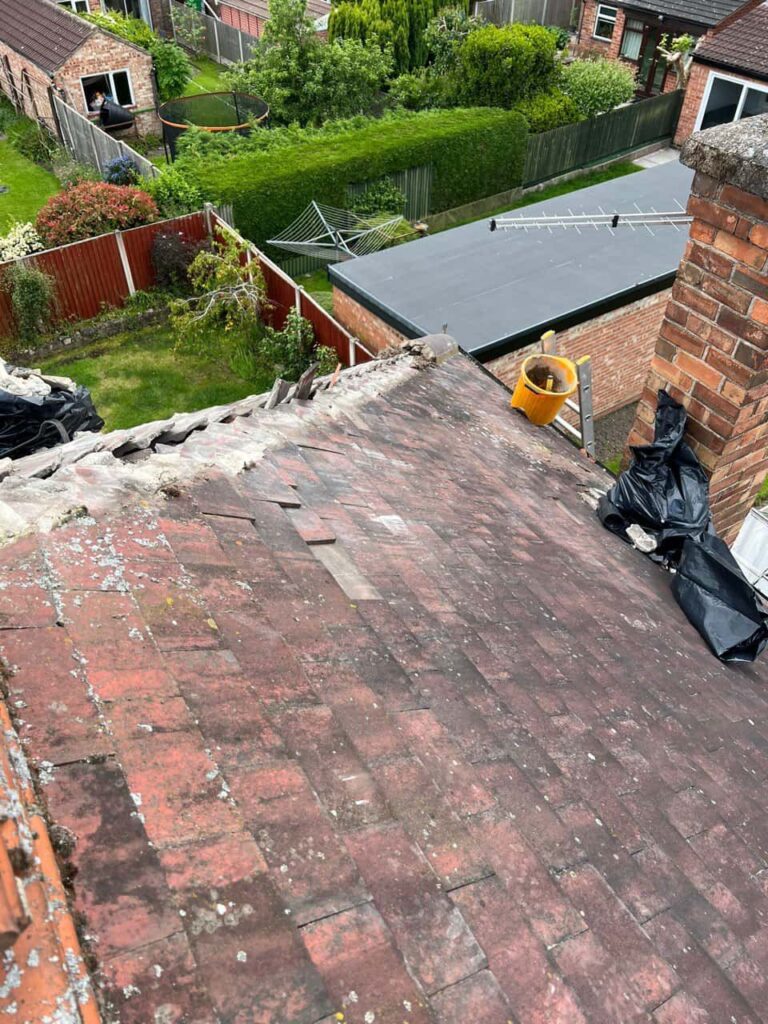Introduction
A leaking roof is one of the most frustrating and potentially costly problems a homeowner can face. What makes it even more aggravating is when the leak keeps coming back, despite efforts to repair it. Persistent roof leaks can damage ceilings, insulation, electrical wiring, and even the structural integrity of your home.
At Beeston Roofing Repairs, we’ve worked with countless homeowners across Beeston and Nottingham to diagnose and fix stubborn roof leaks. The truth is, leaks are often the result of multiple contributing factors—and unless each one is identified and addressed correctly, the problem will continue. Below, we break down the eight most common reasons why your roof might still be leaking and what can be done about it.
Damaged or Missing Roof Tiles
One of the most obvious causes of roof leaks is damaged or missing tiles. Strong winds, frost, or falling debris can loosen or crack tiles, allowing water to seep underneath and into the layers below.
Signs to watch for:
- Visible gaps or slipped tiles
- Piles of tile debris in your gutters
- Water stains directly below affected areas
Even a single broken tile can allow water in, especially during prolonged rain. Prompt replacement with matching tiles is key to maintaining a watertight seal.
Faulty Flashing
Flashing is the thin metal used around chimneys, skylights, roof valleys, and other junctions to direct water away. If flashing is poorly installed, rusted, or detached, it becomes a weak point for leaks.
Common issues:
- Cracked or corroded metal
- Gaps forming at joints or edges
- Poor sealing around vents and fixtures
At Beeston Roofing Repairs, we often find that inadequate flashing work is the root cause of recurring roof leaks—particularly in older homes where the original materials have degraded.
Blocked Gutters and Downpipes
Gutters are essential for directing rainwater off the roof and away from your property. When they become clogged with leaves, moss, or debris, water backs up and can seep beneath the roofline or fascia.
Warning signs:
- Overflowing gutters during rain
- Sagging gutter sections
- Moss growth on walls near the roofline
Routine gutter cleaning helps prevent leaks caused by trapped water. In more severe cases, re-routing or replacing guttering may be necessary.
Poor Roof Ventilation
A lack of proper ventilation in the roof space can lead to condensation build-up, especially in colder months. This internal moisture can mimic the effects of a leak and even contribute to the decay of timber and insulation.
Look out for:
- Damp loft insulation
- Musty smells in the attic
- Mould or mildew on rafters
Effective ventilation keeps the roof space dry and regulates temperature, helping to prevent internal condensation and related damage.
Cracked Leadwork Around Chimneys
Lead flashing around chimneys is another vulnerable area. Over time, lead can crack or lift due to thermal expansion or settlement of the chimney stack.
Indications of failure:
- Water leaks near the fireplace or chimney breast
- Hairline fractures visible on leadwork
- Staining on internal walls beneath the chimney
Replacing or re-bedding the lead flashing is often necessary to resolve leaks originating from chimney structures.
Damaged Roof Valleys
Roof valleys—where two sloping sections meet—channel a significant amount of rainwater. If the material in the valley is compromised, water can quickly find its way through to the underlay or decking.
Typical valley issues:
- Corrosion in metal valleys
- Split felt or flashing along the join
- Debris build-up causing water pooling
Valleys must be free-flowing and securely sealed to prevent water from collecting or being redirected under tiles.
Flat Roof Deterioration
Flat roofs are notoriously prone to leaks, particularly as they age. Cracking, blistering, and pooling water are all signs that the waterproof layer has failed.
Watch for:
- Patches of standing water
- Visible blisters or cracks in the surface
- Damp patches on ceilings beneath the flat roof
At Beeston Roofing Repairs, we offer long-term solutions including flat roof overlays or full membrane replacements where necessary.
Inadequate Previous Repairs
Sometimes, the issue isn’t the roof itself but how previous repairs were carried out. Temporary fixes, incorrect materials, or poor workmanship can allow the same problem to resurface—often worse than before.
Signs of subpar repair:
- Patchy or mismatched materials
- Sealants lifting or peeling
- Leak returns after only a short period
A thorough inspection and a permanent, professional solution are often the only way to fully resolve a recurring leak.
Conclusion
A leaking roof should never be ignored, especially when the issue keeps returning. Often, repeated leaks are the result of multiple overlapping problems, each needing careful diagnosis and skilled repair. Whether it’s flashing, guttering, broken tiles, or poor workmanship, a long-term fix depends on addressing the root cause—not just the symptoms.
At Beeston Roofing Repairs, we provide expert roofing services to homeowners across Beeston and the wider Nottingham area. Our experienced team specialises in identifying persistent leaks and delivering lasting solutions that protect your property for years to come.
If your roof keeps leaking and you’re tired of short-term fixes, get in touch with our team today. Let us help you restore confidence in your roof with quality repairs you can rely on.
Call us on: 0115 647 1193
Click here to find out more about Beeston Roofing Repairs
Click here to complete our contact form and see how we can help with your roofing needs.

